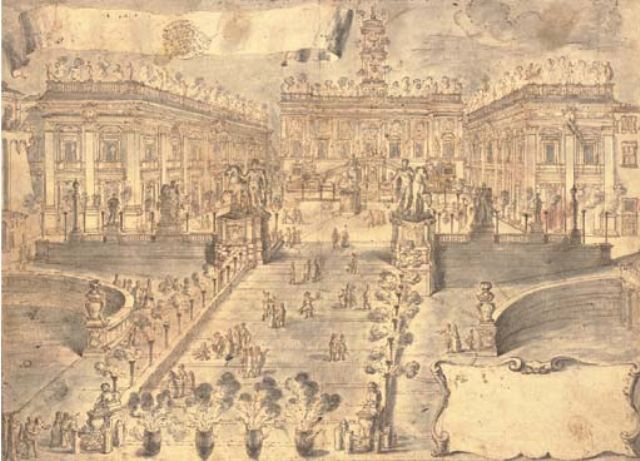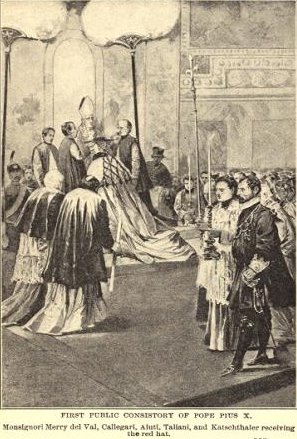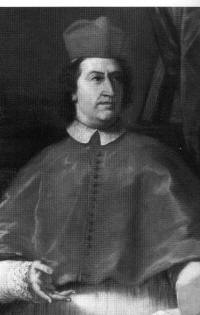|
Pompeo Aldrovandi
Pompeo Aldrovandi (23 September 1668 – 6 January 1752) was an Italian cardinal of the Roman Catholic Church. Biography Aldrovandi was born on 23 September 1668 in Bologna, then part of the Papal States, and studied law at the local university, being awarded a doctorate in canon and civil law in 1691. He entered the Roman Curia five years later and then steadily climbed the career ladder in the administration and was ordained priest in 1710, served as a ''chargé d'affaires'' in the nunciature in Spain from 1712 to 1716. On 5 October 1716 he became titular archbishop of Neocaesarea and was appointed Nuncio in Spain in 1717. However, the political troubles between the Holy See and the King of Spain led to his being recalled to Bologna, where he stayed until the death of Pope Clement XI. On 23 March 1729, he was made titular Patriarch of Jerusalem and was made Governor of Rome and later in 1733 he was appointed Vice-chamberlain of the Apostolic Camera. Aldrovandi was created C ... [...More Info...] [...Related Items...] OR: [Wikipedia] [Google] [Baidu] |
Pompeo Aldrovandini
Pompeo Aldrovandini (1677–1735) was an Italian painter of the Baroque period. Born in Bologna to a family of painters, he mainly learned from his cousin Tommaso Aldrovandini and was employed much in the decoration of churches, palaces, and theatres of Dresden, Prague, and Vienna. He died at Rome Rome (Italian language, Italian and , ) is the capital city and most populated (municipality) of Italy. It is also the administrative centre of the Lazio Regions of Italy, region and of the Metropolitan City of Rome. A special named with 2, .... References * 1677 births 1735 deaths 17th-century Italian painters Italian male painters 18th-century Italian painters Painters from Bologna Italian Baroque painters 18th-century Italian male artists {{Italy-painter-17thC-stub ... [...More Info...] [...Related Items...] OR: [Wikipedia] [Google] [Baidu] |
Nuncio
An apostolic nuncio (; also known as a papal nuncio or simply as a nuncio) is an ecclesiastical diplomat, serving as an envoy or a permanent diplomatic representative of the Holy See to a state or to an international organization. A nuncio is appointed by and represents the Holy See, and is the head of the diplomatic mission, called an apostolic nunciature, which is the equivalent of an embassy. The Holy See is legally distinct from the Vatican City or the Catholic Church. In modern times, a nuncio is usually an Archbishop. An apostolic nuncio is generally equivalent in rank to that of ambassador extraordinary and plenipotentiary, although in Catholic countries the nuncio often ranks above ambassadors in diplomatic protocol. A nuncio performs the same functions as an ambassador and has the same diplomatic privileges. Under the 1961 Vienna Convention on Diplomatic Relations, to which the Holy See is a party, a nuncio is an ambassador like those from any other country. The Vienn ... [...More Info...] [...Related Items...] OR: [Wikipedia] [Google] [Baidu] |
1740 Papal Conclave
The 1740 papal conclave (18 February – 17 August) was convoked after the death of Pope Clement XII on 6 February 1740 and was one of the longest papal conclaves since the 13th century. The initial favourite to succeed as pope, the elderly Pietro Ottoboni (1667–1740), Dean of the College of Cardinals, died shortly after the beginning of the conclave, and cardinals loyal to the House of Bourbon repeatedly proposed Pompeo Aldrovandi, but eventually had to accept that he could not secure two-thirds of the votes. After six months, other possible candidates had also failed, and Cardinal Prospero Lambertini, the archbishop of Bologna, who had been a cardinal since 9 December 1726, was elected. He took the name ''Benedict XIV''. Early candidates The conclave began on 18 February 1740, following the funeral of Clement XII, and lasted for six months. At the outset, only thirty-two cardinals entered into the conclave, in which there was an expectation that the elderly Pietro Ottobon ... [...More Info...] [...Related Items...] OR: [Wikipedia] [Google] [Baidu] |
Diocese Of Montefiascone
The diocese of Montefiascone (''Latin Name: Faliscodunensis o Montis Falisci'') was a Catholic ecclesiastical territory in Italy. It was created from the diocese of Bagnorea in 1369. In 1986 was incorporated into the diocese of Viterbo, Acquapendente, Bagnoregio, Montefiascone, Tuscania e San Martino al Monte Cimino."Diocese of Montefiascone" '' Catholic-Hierarchy.org''. David M. Cheney. Retrieved February 29, 2016."Titular Episcopal See of Montefiascone" ''GCatholic.org''. Gabriel Chow. Retrieved February 29, 2016. Th ... [...More Info...] [...Related Items...] OR: [Wikipedia] [Google] [Baidu] |
Papal Consistory
In the Catholic Church, a consistory is a formal meeting of the College of Cardinals called by the pope. There are two kinds of consistories, extraordinary and ordinary. An "extraordinary" consistory is held to allow the pope to consult with the entire membership of the College of Cardinals. An "ordinary" consistory is ceremonial in nature and is normally attended by cardinals resident in Rome. For example, the pope elevates new cardinals to the College at a consistory; Pope Francis called consistories for ceremonies of canonization; and Pope Benedict announced his decision to retire in 2013 at a consistory. A meeting of the College of Cardinals to elect a new pope is not a consistory, but a conclave. History The term ''consistory'' comes from the ; "stand together".''Papal Consistory'' by Kevin Knight (Catholic Encyclopedia, 2009) ... [...More Info...] [...Related Items...] OR: [Wikipedia] [Google] [Baidu] |
Cardinal Priest
A cardinal is a senior member of the clergy of the Catholic Church. As titular members of the clergy of the Diocese of Rome, they serve as advisors to the pope, who is the bishop of Rome and the visible head of the worldwide Catholic Church. Cardinals are chosen and formally created by the pope, and typically hold the title for life. Collectively, they constitute the College of Cardinals. The most solemn responsibility of the cardinals is to elect a new pope in a conclave, almost always from among themselves, with a few historical exceptions, when the Holy See is vacant. During the period between a pope's death or resignation and the election of his successor, the day-to-day governance of the Holy See is in the hands of the College of Cardinals. The right to participate in a conclave is limited to cardinals who have not reached the age of 80 years by the day the vacancy occurs. With the pope, cardinals collectively participate in papal consistories, in which matters of importa ... [...More Info...] [...Related Items...] OR: [Wikipedia] [Google] [Baidu] |
Apostolic Camera
The Apostolic Camera (), formerly known as the was an office in the Roman Curia. It was the central board of finance in the papal administrative system and at one time was of great importance in the government of the States of the Church and in the administration of justice, led by the Camerlengo of the Holy Roman Church, originally known as ''camerarius (''chamberlain). In 2022, Pope Francis's apostolic constitution abolished the office as of 5 June. History The office of camerarius (chamberlain) was established by Pope Urban II. Since the middle of the 12th century the Papal chamberlain (') was a regular member of the Curia, entrusted with the financial management of the papal court. At that early period the income of the papal treasury came chiefly from many kinds of censuses, dues, and tributes paid in from the territory subject to the Pope, and from churches and monasteries immediately dependent on him. Cencius Camerarius (later Pope Honorius III, r. 1216–1227) ma ... [...More Info...] [...Related Items...] OR: [Wikipedia] [Google] [Baidu] |
Rome
Rome (Italian language, Italian and , ) is the capital city and most populated (municipality) of Italy. It is also the administrative centre of the Lazio Regions of Italy, region and of the Metropolitan City of Rome. A special named with 2,746,984 residents in , Rome is the list of cities in the European Union by population within city limits, third most populous city in the European Union by population within city limits. The Metropolitan City of Rome Capital, with a population of 4,223,885 residents, is the most populous metropolitan cities of Italy, metropolitan city in Italy. Rome metropolitan area, Its metropolitan area is the third-most populous within Italy. Rome is located in the central-western portion of the Italian Peninsula, within Lazio (Latium), along the shores of the Tiber Valley. Vatican City (the smallest country in the world and headquarters of the worldwide Catholic Church under the governance of the Holy See) is an independent country inside the city boun ... [...More Info...] [...Related Items...] OR: [Wikipedia] [Google] [Baidu] |
Latin Patriarch Of Jerusalem
The Latin Patriarchate of Jerusalem () is the Latin Catholic ecclesiastical patriarchate in Jerusalem, officially seated in the Church of the Holy Sepulchre. The Latin Patriarch of Jerusalem is the archbishop of Latin Church Catholics of the Archdiocese of Jerusalem with jurisdiction for all Latin Catholics in Israel, Palestine, Jordan and Cyprus; he also holds the office of grand prior of the Order of the Holy Sepulchre. It is exempt, being directly subject to the Holy See (and exceptionally its Dicastery for the Eastern Churches, which normally handles Eastern Catholics). It is not within an ecclesiastical province, and has no metropolitan functions. The Patriarchate was originally established in 1099, with the Kingdom of Jerusalem encompassing the territories in the Holy Land newly conquered by the First Crusade. From 1374 to 1847 it was a titular see, with the patriarchs of Jerusalem being based at the Basilica di San Lorenzo fuori le Mura in Rome. Pope Pius IX r ... [...More Info...] [...Related Items...] OR: [Wikipedia] [Google] [Baidu] |
Pope Clement XI
Pope Clement XI (; ; ; 23 July 1649 – 19 March 1721), born Giovanni Francesco Albani, was head of the Catholic Church and ruler of the Papal States from 23 November 1700 to his death in March 1721. Clement XI was a patron of the arts and of science. He was also a great benefactor of the Vatican Library; his interest in archaeology is credited with saving much of Rome's antiquity. He authorized expeditions which succeeded in rediscovering various ancient Christian writings and authorized excavations of the Roman catacombs. Biography Early life Giovanni Francesco Albani was born in 1649 in Urbino to the Albani family, a distinguished family of Albanian origin in central Italy. His mother Elena Mosca (1630–1698) was a high-standing Italian of bergamasque origin, descended from the noble Mosca family of Pesaro. His father Carlo Albani (1623–1684) was a patrician. His mother descended in part from the Staccoli family, who were patricians of Urbino, in part from the Gior ... [...More Info...] [...Related Items...] OR: [Wikipedia] [Google] [Baidu] |
King Of Spain
The monarchy of Spain or Spanish monarchy () is the constitutional form of government of Spain. It consists of a Hereditary monarchy, hereditary monarch who reigns as the head of state, being the highest office of the country. The Spanish monarchy is constitutionally referred to as The Crown (), and it comprises the reigning List of Spanish monarchs, monarch, currently King Felipe VI, their family, and the Royal Household of Spain, Royal Household, which supports and facilitates the sovereign in the exercise of his duties and prerogatives. The Spanish royal family, royal family is currently represented by King Felipe VI, Queen Letizia, their daughters Leonor, Princess of Asturias, and Infanta Sofía, and the king's parents, Juan Carlos I, King Juan Carlos I and Queen Sofía of Spain, Queen Sofía. The Spanish Constitution of 1978 re-established a constitutional monarchy as the form of government for Spain after the end of the dictatorship of Francisco Franco and the resto ... [...More Info...] [...Related Items...] OR: [Wikipedia] [Google] [Baidu] |
Holy See
The Holy See (, ; ), also called the See of Rome, the Petrine See or the Apostolic See, is the central governing body of the Catholic Church and Vatican City. It encompasses the office of the pope as the Bishops in the Catholic Church, bishop of the apostolic see, apostolic episcopal see of Diocese of Rome, Rome, and serves as the spiritual and administrative authority of the worldwide Catholic Church and Vatican City. Under international law, the Legal status of the Holy See, Holy See holds the status of a sovereign juridical entity. According to Sacred tradition, Catholic tradition and historical records, the Holy See was founded in the first century by Saint Peter and Paul the Apostle, Saint Paul. By virtue of the doctrines of Primacy of Peter, Petrine and papal primacy, papal primacy, it is the focal point of full communion for Catholics around the world. The Holy See is headquartered in, operates from, and exercises "exclusive dominion" over Vatican City, an independent c ... [...More Info...] [...Related Items...] OR: [Wikipedia] [Google] [Baidu] |






